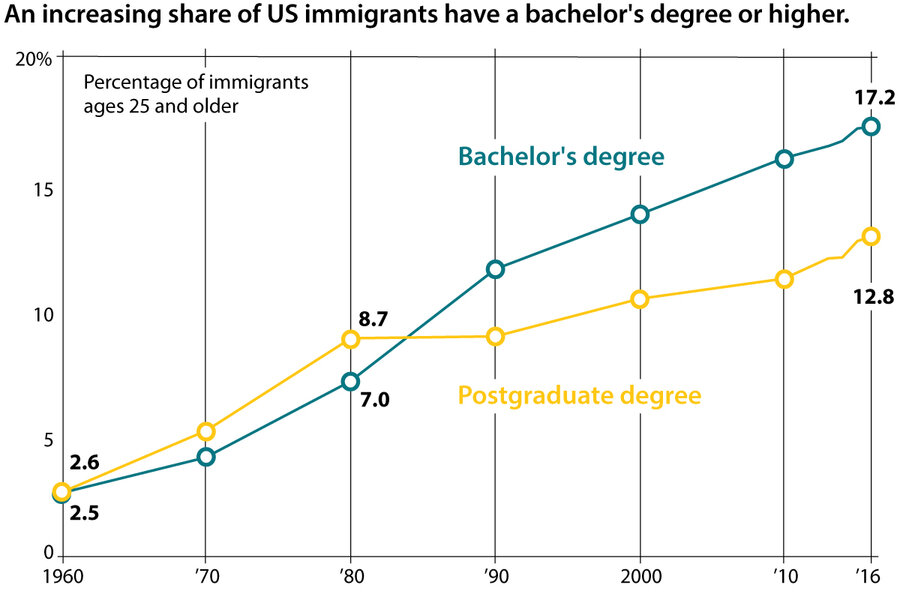What’s made rates of degree attainment for immigrant students spike?
Loading...
The education level of immigrants in the US is rising. In 1980, about 16 percent of immigrants had earned a bachelor’s degree. By 2016, the number had grown to 30 percent, according to the Pew Research Center, virtually matching the level of attainment of US-born residents.
And while immigrants from South and East Asia are most likely to hold a bachelor’s degree, progress has been broad. For example, the number of Mexican immigrants 25 and older with a high school diploma has more than doubled since 1980 – from 11.4 to 25.2 percent. One driver, observers say, and the key to sustain progress: programs that provide long-term support – tutoring, mentoring.
“The whole process is so daunting,” says Sandra Cañas at Enroot, a nonprofit in Cambridge, Mass., that works with immigrant high school students. “We feel that it is important that students get the support they need for whatever they want to do.”
Why We Wrote This
So much of the coverage of immigrants to the US focuses on their status, and on their needs. We decided to look at something else: their three decades of educational attainment.
At Cambridge Rindge and Latin School (CRLS) in Cambridge, Mass., students flood into the international student center after the bell rings, marking the end of the school day.
One of them is Nafis Rahman, a high school senior from Bangladesh who arrived in the United States in 2016. After spending his first year in classes specifically for English-language learners, he’s now able to take courses with the mainstream students at CRLS. His favorite: Advanced Placement Computer Science.
Greeting him and others are staff from Enroot, a nonprofit that works with immigrant high school students in Cambridge and Somerville, Mass. They pepper the students with questions: Are you coming to the leadership workshop this week? When was the last time you talked to your mentor?
Why We Wrote This
So much of the coverage of immigrants to the US focuses on their status, and on their needs. We decided to look at something else: their three decades of educational attainment.
It’s the kind of holistic approach that students like Nafis say they find helpful. He has received tutoring, mentoring, and an internship from Enroot – and is now applying to college.
“Tomorrow I’m going to submit applications to all the UMass [schools] and WPI,” he says, referring to Worcester Polytechnic Institute in Worcester, Mass.
Across the country, the education levels of immigrants have been steadily rising over the past several decades, partly because of programs like Enroot that focus on providing long-term support. In 1980, about 16 percent of immigrants had earned a bachelor’s degree. By 2016, the number grew to 30 percent, according to the Pew Research Center. This increase has all but closed the gap between immigrants and US-born residents: 31.6 percent of those born in the US have a bachelor’s degree.
While immigrants from South and East Asia are most likely to hold a bachelor’s degree, and college graduates from those groups are more likely to remain in the US to work, educational attainment is rising among all ethnicities and origin countries. For example, the number of Mexican immigrants 25 and older with a high school diploma has more than doubled since 1980 – from 11.4 to 25.2 percent.
Educators who work with immigrant students, especially at the high school level, say it’s necessary to take the long view to see those numbers rise even more.
Sandra Cañas, Enroot’s Cambridge program director, has found that many of the immigrant students who arrive at CRLS are highly driven and hold themselves to high standards but need extra resources as they adjust to a new learning experience.
“Some of the students come with one parent, and they don’t have the support or the guidance they need to make decisions in regards to school issues,” she says. “The whole process is so daunting ... we feel that it is important that students get the support they need for whatever they want to do.”
The Cabrillo Advancement Program (CAP) supports low-income students – primarily immigrants and first-generation Americans – in California’s Santa Cruz County. The Cabrillo College program accepts students in sixth grade and mentors them for the next six years, along with guaranteeing them a scholarship at Cabrillo College. The program looks to address two potential hurdles: Mindsets that may discourage students from pursuing higher education, and resource gaps that may prevent them from doing so.
Catherine Cooper, a psychology professor at University of California, Santa Cruz and the director of the Bridging Multiple Worlds Alliance, has worked with CAP’s coordinator and leader Elizabeth Dominguez to study the resources – or capital – that immigrant and first-generation students can leverage to succeed. Many students have family support and their own dreams to push them forward. In the program, they learn skills – like leadership – that can help them turn those dreams into reality.
“The whole idea of navigational capital is what we teach in our summer [leadership] institute, which is, how can you navigate the bureaucracy and find out how to get that scholarship, or … can we get a fee waiver to take the SAT?” Dr. Cooper explains.
Programs like Enroot and CAP can help immigrant students feel more confident.
Deborah Midy, a junior at CRLS from Haiti, has visited colleges with her mentor and discussed the future over coffee. Like Nafis, she started with classes for English-language learners but is now taking honors classes with other students. In college, she wants to study architecture. She credits the English classes for preparing her, particularly because of a good teacher.
“[The classes] helped because the teacher took her time and she was patient with me,” she says. “She wouldn’t rush or be nervous when I didn’t understand.”









